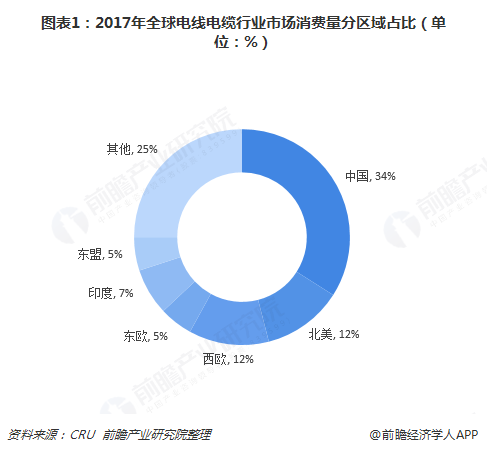Send Time:2019-4-9
Market Profile and Development Prospects of the Wire and Cable Industry in 2019
Source: Cable recruitment network
Wire and cable belong to what trade?
Wire and cable belong to the electrical machinery and equipment manufacturing industry in the National Economic Industry Classification. The reasons are as follows:
1. The original Ministry of Machinery Industry, communication cables, cables, and optical cables later belonged to the Ministry of Posts and Telecommunications
2. It belongs to the electrical machinery and equipment manufacturing industry. Accurate and reasonable should belong to the electrical and electronic industry.
3. Electrical cables are installation materials in the construction process of building materials
What are the characteristics of wires and cables?
Where there are people in our daily life, where there are production, transportation and all economic activities, electricity is indispensable. The occurrence, transmission and application of electricity must use wire and cable as a part of connection, transmission, or as a winding material for the host. So, let's get to know each other. The wire and cable originally belonged to the machinery industry and belonged to the jurisdiction of the Ministry of Machinery. After the Ministry of Machinery was withdrawn, it was now the wire and cable industry association. From the roots, it was a mechanical product because the processing process was: pulling, pulling, twisting, winding, and squeezing. However, when the quality management system is certified, it is divided into electromechanical industries and belongs to electromechanical products. Wire cables are used to transmit transmission(magnetic) energy, information, and wire products that realize electromagnetic energy conversion. Generalized wire cables are also referred to simply as cables. Narrow cables refer to insulated cables. It can be defined as: a collection consisting of the following parts; One or more insulation cores, and each of them may have a cladding layer, a total protective layer and an outer protective layer, and cables can also have additional uninsulated conductors. Wire products used to transmit transmission(magnetic) energy, information, and realize electromagnetic energy conversion. Generalized wire cables are also referred to simply as cables, and narrow cables refer to insulated cables. It can be defined as a combination of one or more insulating cores, as well as the cladding layer they may have, the total protective layer and the outer protective layer, and the cable can also have an additional uninsulated conductor. In a sense, the wire and cable manufacturing industry is a material finishing and assembly industry. First, the amount of materials used is huge, and the cost of materials in cable products accounts for 80-90 % of the total manufacturing cost; The second is that the types and varieties of materials used are very large, and the performance requirements are particularly high. For example, copper for conductors requires that the purity of copper be above 99.95 %, and some products should use anaerobic Gaochun copper; Third, the selection of materials will have a decisive impact on the manufacturing process, product performance and service life. After you read the above, you should have a deeper understanding of the wires and cables. In fact, wires and cables are like blood vessels for the human body; Comparing electromagnetic waves to the nerves of the human body; Electromagnetic wire ratio is used as an important component in the heart. This shows the indispensability of wire and cable in all economic activities and social life.
The development prospect of the wire and cable industry in 2019
A Overview of the Development of the Cable Industry in China
As one of the largest supporting industries in the national economy, wire and cable are the basis of various industries. Their products are widely used in power, construction, civil use, communications, ships, military industry, aviation, and petrochemical industries. Wire and cable can be divided into power cables, electrical equipment cables, winding lines, naked wires, communication cables and wires and cable accessories according to the purpose. From the 2017 breakdown of the cable industry in China, power cables occupy the largest part of the wire and cable business. The scale accounted for 35.7 %, followed by electrical equipment cables and winding lines, accounting for 20 % and 15.7 % respectively.
In recent years, the economic growth of emerging Asian countries has been relatively fast. The world's production center of wire and cable has shifted to Asia, which has driven the rapid development of the wire and cable industry in countries such as China, Vietnam, the Philippines and Egypt in the Middle East, thus achieving steady growth in the global wire and cable industry. According to the data, the global electricity cable market revenue in 2014 was about US$ 153.2 billion, and by 2017 the global power cable industry revenue was about US$ 207.3 billion, an increase of 7.9 % from 2016.
In terms of subregions, the China-dominated Asian region has risen rapidly, and the Americas region has risen slowly. In recent years, the development of the European region has been relatively unstable and has been greatly affected by economic and political factors. According to CRU data, in 2017, China's cable consumption accounted for 34 % of the global total(based on the conductor weight of metal cables), North America accounted for 12 %, Western Europe accounted for 12 %, Eastern Europe accounted for 5 %, India accounted for 7 %, and ASEAN accounted for 5 %.

It is worth mentioning that although China's wire and cable industry has made great progress, sales revenue may even exceed 1.4 trillion yuan in 2018, but the industry still walks on the road of extensive development, especially in brand management and new technology research and development, application and other fields to be improved. Moreover, the domestic wire and cable industry is "big and not strong" and the market concentration is extremely low.

The top 10 cable manufacturers(such as General Motors, Batcom, Corning, South Line, etc.) account for about 70 % of the market share, and Japan's seven major cable companies(such as Furukawa, Sumitomo, Tengcang, Hitachi, Showa, etc.) account for more than 66 % of the market share. The five major French cable companies(Nexen, Xinxin, etc.) occupy more than 90 % of the French market. The number of enterprises above the scale of China is only more than 4,000, and the top ten cable companies account for less than 10 % of the domestic market.
China Wire and Cable Industry Manufacturing Map
As a result, the world's influential cable makers remain concentrated in the developed world, and none of the top 10 countries belongs to China. In 2017, the top ten manufacturers of the global power cable industry were Prysiman, Nexson, Sumitomo Electric, Furukawa Electric, General Cable, South Cable, Ankaite Cable, Lennon Cable, LS Cable, and Fujikura Cable.

In addition, under the steady development of the global power cable market, the global metal insulated cable market consumption has maintained a relatively stable growth. Before 2015, the industry grew faster, and since then the growth rate has begun to slow, with a growth rate of 1.8 % in 2015. According to CRU estimates, in 2018, the market consumption of metal insulated wires and cables was around 18.9 million tons.

In terms of specific products, in 2017, low-voltage power cables accounted for 40 % of the total market demand for insulated wires and cables, followed by copper-guided power cables, accounting for 25 %, winding lines accounted for 15 %, data cables accounted for 10 %, aluminum power cables accounted for 8 %, communication cables accounted for 2 %.

China Cable and Wire Market Potential
In terms of market supply and demand, the global cable market has matured and growth has been slow. The domestic and international tracking and analysis of the development of the cable industry shows that as long as a country or region's economy is under the premise of growth, especially in the process of industrialization and urbanization, the growth of the cable industry in the country will be above the GDP growth rate. China's per capita GDP is far lower than that of developed countries, and per capita cable usage is much lower than that of developed countries in Europe and even developing countries such as Latin America.
The future demand growth of China's cable industry mainly comes from two major aspects: First, high voltage, ultra-high voltage power cable market demand. Under the economic development concept of energy conservation and environmental protection, high-and ultra-high-voltage transmission, characterized by "high energy efficiency and low losses", has become an inevitable direction for the development of the power industry. Due to its many advantages such as "large capacity, high reliability, and maintainability", high-voltage and ultra-high voltage power cables have been increasingly used in long-distance and long-span transmission lines. High-voltage and ultra-high voltage power cables gradually replace medium-low voltage power cables is an inevitable trend in the development of the industry. The construction of high-voltage, ultra-high voltage and ultra-high voltage transmission lines will bring huge market demand for lead products such as aluminum alloy conductors and Gaodianya grade power cables.
Second, the demand for railway and urban rail transit has grown rapidly. According to the 13th Five-Year Plan for the Development of a Modern Integrated Transport System, during the 13th Five-Year Plan period, China's railway and urban rail transport will continue to maintain the momentum of rapid growth and sound development. Railway operating mileage will increase from 121,000 public in 2015 to 150,000 kilometers in 2020, high-speed railway operating mileage will increase from 19,000 kilometers in 2015 to 30,000 kilometers in 2020, and urban rail transit operating mileage will increase from 3,300 kilometers in 2015 to 6,000 kilometers in 2020. The increase of urban track investment will effectively drive the further development of the cable industry.
The above data sources refer to the "Report on Forecasting and Investment Strategic Planning for the Development of the Wire and Cable Industry in China" issued by the forward-looking Industrial Research Institute.
欢迎咨询
我们会尽快联系您
